Specifications, delivery set
| Manufacturer | MSI |
|---|---|
| Series | MAG |
| Model | MSI MAG CoreLiquid E360 |
| Model code | EAN: 4711377115735 |
| Cooling system type | closed-loop liquid pre-filled non-expandable for processor |
| Compatibility | motherboards with processor sockets: Intel: LGA 1700 , 1200, 115x; AMD: AM5, AM4, TR4, sTRx4 |
| Fan type | axial (axial), 3 pcs. |
| Fan model | FD12025L12SPAA |
| Connecting fans | motor: 12 V, 0.25 A (nominal) / 0.4 A (maximum), 4-pin connector (common, power, rotation sensor, PWM control); RGB: 3-pin header (addressable LED — general, data, 5V power) |
| Fan dimensions | 120×120×25 mm |
| Fan speed | 600—1800 rpm |
| Fan performance | 43.3 — 127.5 m³/h (25.5 — 75.04 ft³/min) |
| Fan static pressure | 3.0–24.7 Pa (0.31–2.52 mm water column) |
| Fan noise level | 11.2—32.5 dBA |
| Fan bearing | hydrodynamic (FDB, Fluid Dynamic Bearing) |
| Expected fan life | 50,000 h at 40 °C |
| Radiator dimensions | 394×119×27 mm |
| Radiator material | aluminum |
| Flexible line length | 400 mm |
| water pump | integrated with heat sink |
| Pump dimensions (L×W×H) | no data |
| Connecting the pump | motor: 12 V, 0.25 A (nominal) / 0.5 A (maximum), 4-pin connector (common, power, rotation sensor, PWM control); RGB: 3-pin header (addressable LED — general, data, 5V power) |
| Pump rotation speed | 3000 rpm |
| Pump noise level | 20 dBA |
| Expected pump life | 200,000 h |
| Heat sink material | copper |
| Thermal interface of the heat sink | thermal paste in a syringe |
| Peculiarities |
|
| Contents of delivery |
|
Description
We tested the black model of the MSI MAG CoreLiquid E360 liquid cooling system. However, according to information on the manufacturer's website, a white version of the same system is also available.
The liquid cooling system comes in a box made of medium-thick corrugated cardboard.
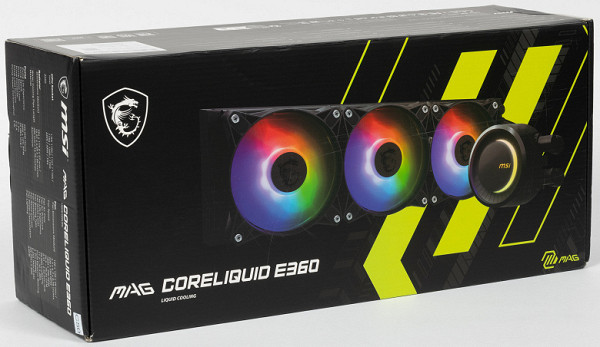
Inside the box we found almost everything listed in the table above, the only thing missing was a simple resistor-less splitter for powering the fans:
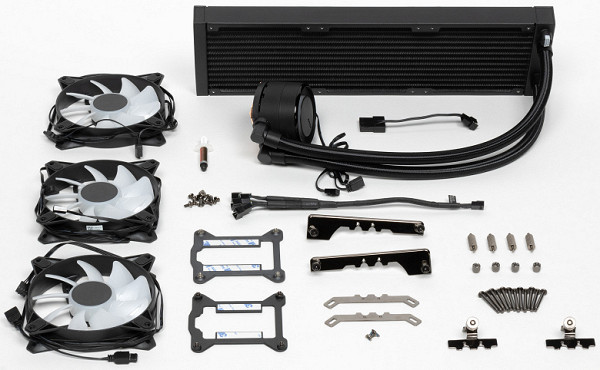
Installation instructions are not included in printed form; it is proposed to download it from the company’s website using a QR code.
The liquid cooling system is sealed, already charged and ready for use. The pump is integrated into one block with a heat exchanger. The copper plate serves as the heat exchanger base, directly adjacent to the processor cover. Its outer surface is ground and lightly polished. The surface is convex, with a slight height difference of about 0.2 mm to the center.
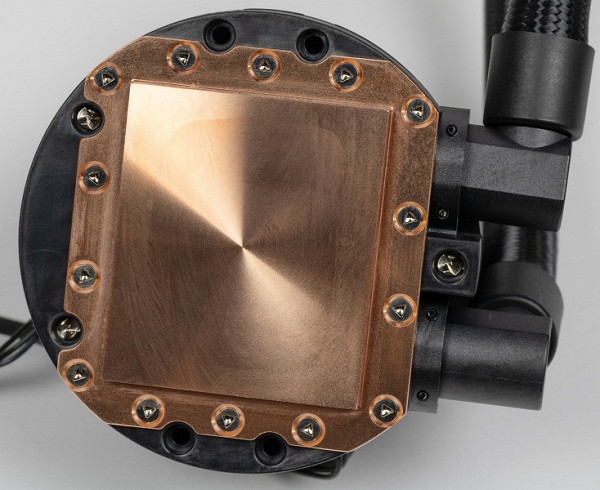
The dimensions of the working part of this plate are 47.5×41 mm.
The thermal paste comes in a small syringe, which is of course less convenient than a pre-applied layer. The supplied thermal paste is enough for exactly one application, and, at best, for two if the processor has a small cover area and thermal paste consumption is minimal. All tests used high-quality thermal paste from another manufacturer.
We demonstrate in advance the distribution of thermal paste after completing all tests on the Intel Core i9-13900K processor:

And on the base of the pump:

It can be seen that the thermal paste is evenly distributed over almost the entire area of the processor cover, with excess extending beyond the edges. The area of tight contact is located approximately in the center and has a significant area. However, a slight distortion is noticeable — the layer of thermal paste is thicker at one edge. It is difficult to correct this misalignment due to the convex shape of the thermal block and the inability to adjust the clamping force, since all four nuts have to be tightened all the way. (The distribution of thermal paste, of course, changes slightly when removing the processor and pump.)
The pump body is made of durable black plastic.
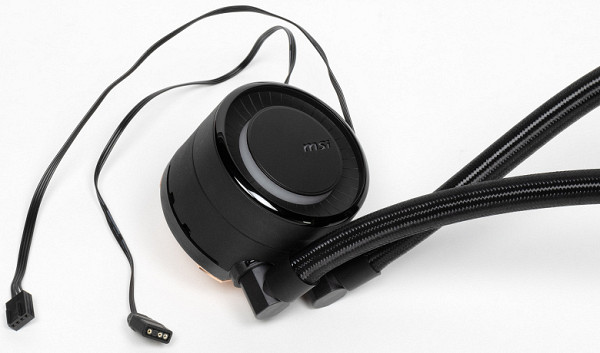
The illuminated cover can be rotated approximately 270 degrees relative to the pump body, allowing the logo to be installed in the correct orientation in most cases. The pump height is 55 mm, the body diameter is 75 mm. Two cables come from the pump: the first (30 cm long) with a 3-pin header connects to the ARGB lighting on the motherboard or controller; the second (29.5 cm long) with a 4-pin connector is designed to connect to the fan or pump connector on the motherboard. The rotation speed of the pump can be adjusted by changing the PWM or voltage.
The hoses are elastic and relatively flexible, covered with a slippery plastic braid. The outer diameter of braided hoses is approximately 12.5 mm. The length of the hoses along the flexible part excluding sleeves is 37.5 cm (quite long). The L-shaped fittings at the pump inlet rotate, making installation of the system easier.
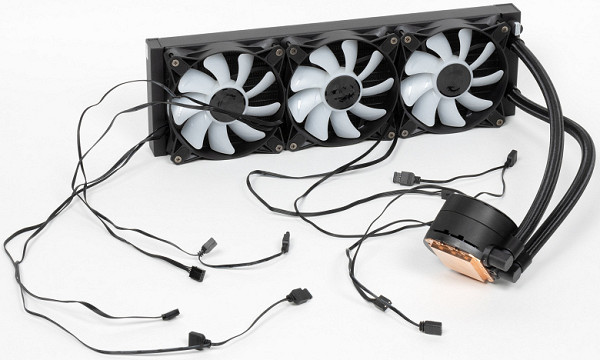
The radiator is made of aluminum and painted matte black, which demonstrates sufficient resistance to damage.
The fan frame is made of durable black plastic. Rubber vibration-isolating pads are installed on the corners of the frames. However, due to the weight of the fan and the properties of these pads, it is safe to say that this system does not have significant anti-vibration properties in any case due to the high resonant frequency.
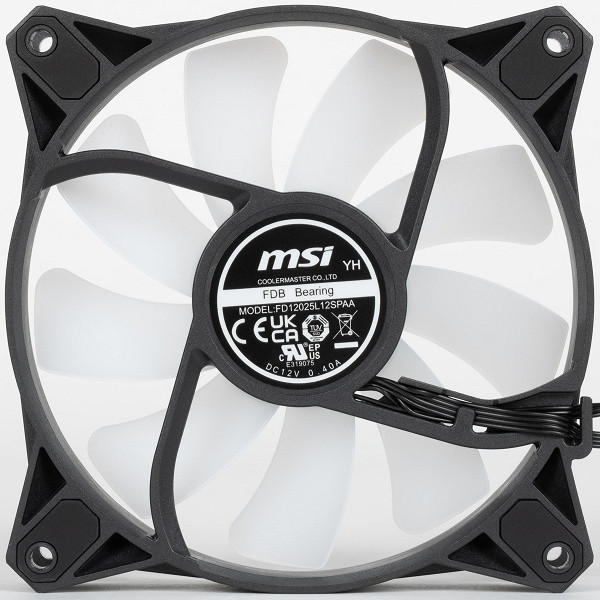
The fans support PWM control. The fan impeller is made of white translucent plastic, which is illuminated by internal ARGB LEDs located around the circumference of the stator. Fan cables have standard four- and three-pin connectors for connecting to motors and addressable lighting. The lengths of these cables are 50 cm and 55 cm (+10 cm to the feed-through connector) respectively.
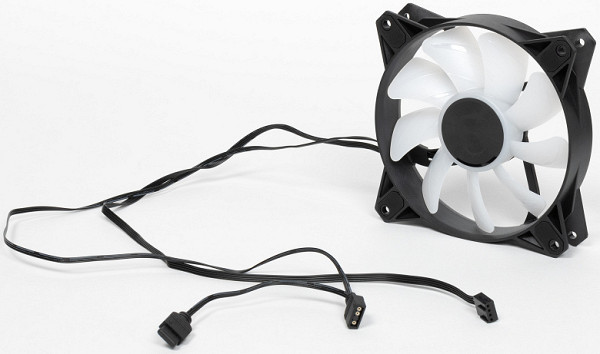
The operation of the pump and fan lights (default mode when connected to a third-party controller) is shown in the video below:
The assembled system with fasteners for the LGA 1700 socket weighs 1603 grams. The fasteners are made primarily of hardened steel and have a durable galvanized coating. The frames on the back of the motherboard (for Intel processors) are made of durable plastic and equipped with steel threaded sockets.
Testing
Determining the dependence of the cooler fan speed on the PWM duty cycle and/or supply voltage
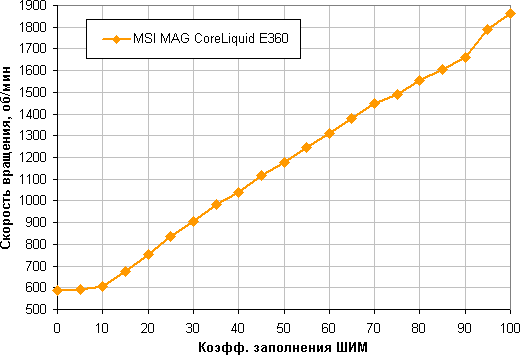
An excellent result — the fan speed changes monotonically and almost linearly when the fill factor changes from 10% to 100%. The rotation speed adjustment range is wide. When the duty cycle (PWM) drops to 0%, the fans do not stop. This can be useful for creating a hybrid cooling system that operates partially or completely in passive mode at low loads.
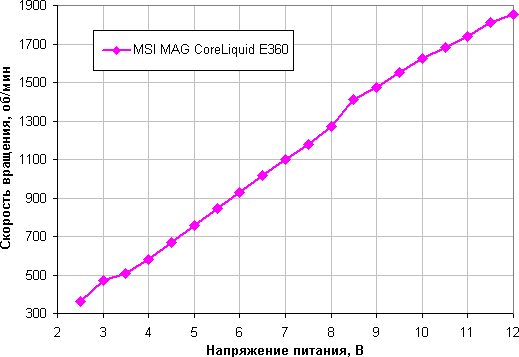
Voltage control ensures that the fans rotate consistently over a slightly wider range. The fans stop when the voltage drops to 1.9-2.0 V and start from 3.1-3.4 V. The fans can be safely connected to a 5 V source. Using the included fan splitter with resistors to power the fans reduces the maximum rotation speed to 1500 rpm
The pump rotation speed is also controlled using PWM and supply voltage. We will provide the corresponding graphics.
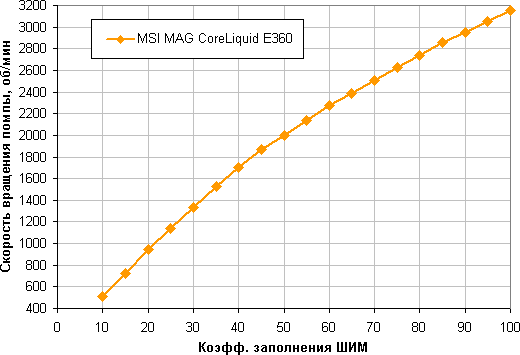

When the fill factor (FC) decreases to 5%, the pump stops and starts at 6% (12 V power supply). The pump stops at 4.7 V and starts at 4.8 V. It is not recommended to connect the pump to a 5 V power source.
Determining the dependence of the processor temperature when it is fully loaded on the rotation speed of the cooler fans
In this test, all cores of the Intel Core i9-13900K processor ran at 4.1 GHz. The pump and fans on the radiator were controlled using PWM.
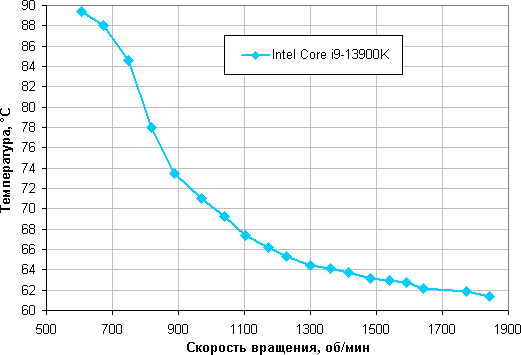
In this test, the Intel Core i9-13900K processor at an ambient temperature of 24 degrees does not overheat at fan speeds achieved when the duty cycle is reduced to 20%, which corresponds to approximately 750 rpm. At the same time, the maximum energy consumption recorded during the monitoring process was about 217 W, while consumption of up to 289 W was observed for the processor power connectors. It is important to note that the base thermal power of this processor is 125 W, and the standard maximum short-term mode (turbo limit) is 253 W.
Determining the noise level depending on the rotation speed of the cooler fans
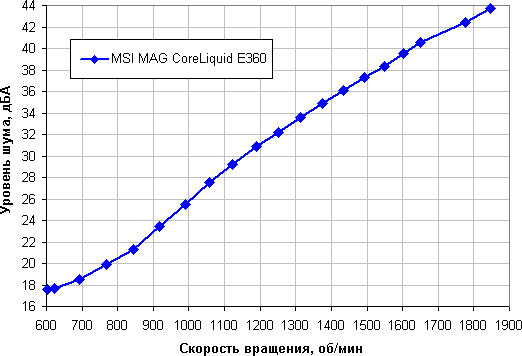
The noise level of this cooling system varies over a wide range. It is noted that noise characteristics may depend on individual characteristics and other factors. Based on our observations:
- Noise levels of 40 dBA or higher are considered very high for a desktop system.
- Noise levels between 35 and 40 dBA are considered acceptable.
- Noise below 35 dBA does not stand out much compared to typical PC components such as case fans, power supply fans, graphics cards and hard drives.
- Noise levels below 25 dBA can be considered conditionally silent.
The background noise level during testing was 16.4 dBA (conventional value reflecting the readings of the sound level meter).
Plotting the dependence of real maximum power on noise level
Let's move from the test bench conditions (24 degrees ambient) to more realistic scenarios. Assume that the temperature of the air entering the cooling system through the fans can reach up to 44°C. This is a typical scenario, for example, when liquid-air cooling is installed to blow air out of a case containing a powerful graphics card. However, we do not want the processor temperature to exceed 80°C under maximum load. Based on these conditions, we will plot the dependence of the actual maximum power consumed by the processor (denoted as Pmax, previously the designation Max. TDP was used) on the noise level.
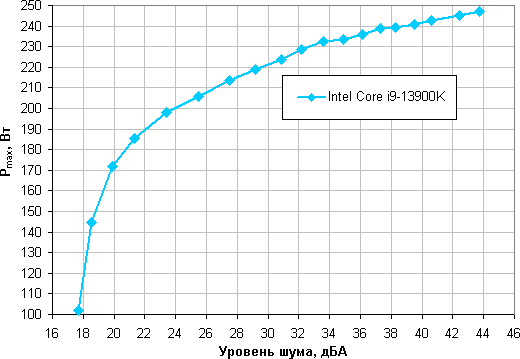
Taking 25 dBA as a criterion for conditional noiselessness, we can determine the approximate maximum processor power that corresponds to this noise level. For an Intel Core i9-13900K processor, this is about 205 W. However, if you do not take into account the noise level, the power limits can be increased to almost 250 W. Let us repeat once again that these values apply provided that the radiator is blown with air heated to 44°C. If the ambient temperature decreases and/or the maximum permissible processor temperature increases (permissible temperature up to 100°C), the specified power limits for silent operation and maximum power may be higher.
conclusions
To properly understand the findings, the following should be considered: the purpose of testing is primarily to evaluate the cooling capacity of a liquid cooling system (LCS). Processors are used exclusively as thermal load elements to determine the conditional thermal resistance of the LSS in various modes. Thus, the power (heat dissipation) of the processor is artificially adjusted depending on the capabilities of the cooling system, and can be either lower or higher than the standard operating modes of the processor. The main requirement is that, within the entire range of the cooling capacity of the LCS, the processor does not overheat, while there is a significant difference in the change in processor temperature.
Based on the MSI MAG CoreLiquid E360 liquid cooling system, it is possible to create a conditionally silent computer (noise level 25 dBA or lower) equipped with an Intel Core i9-13900K processor. This is achieved provided that the consumption of the same or similar processor under maximum load does not exceed 205 W, the temperature inside the case does not rise above 44°C, and the maximum processor temperature is limited to 80°C. If the cooling air temperature is lower, the processor temperature threshold is higher (up to 100°C), or noise requirements are less stringent, you can increase the power limits. In fact, if you do not overclock the Intel Core i9-13900K and do not increase its power, then this cooling system is enough to provide silent cooling in any real load scenarios. Internal decoration
